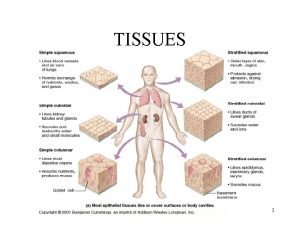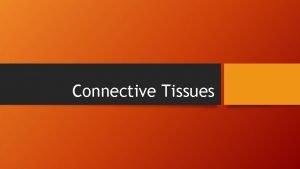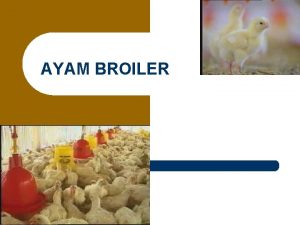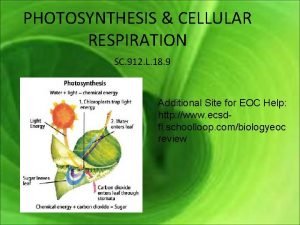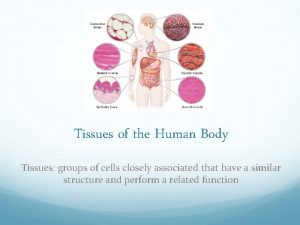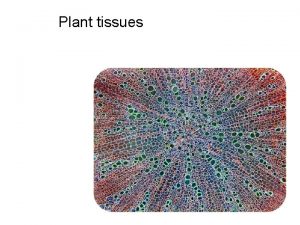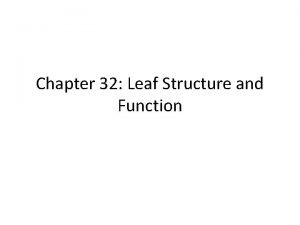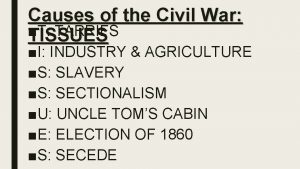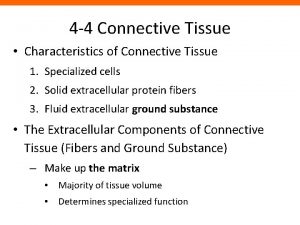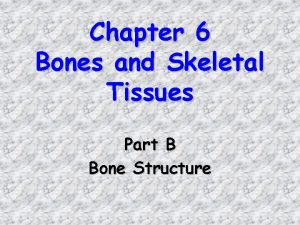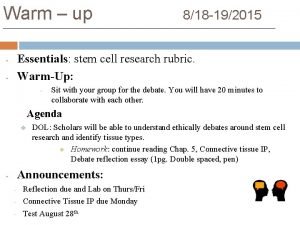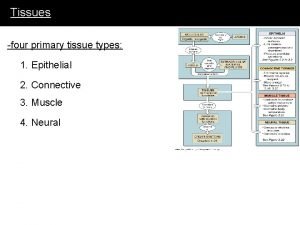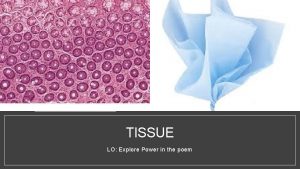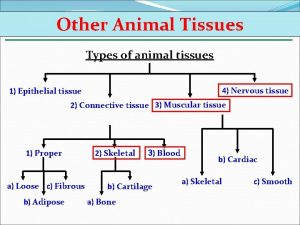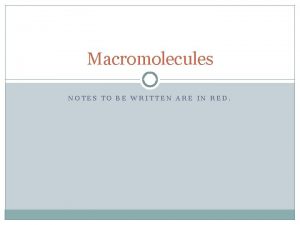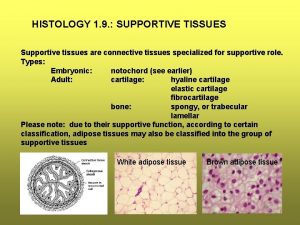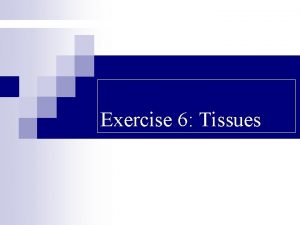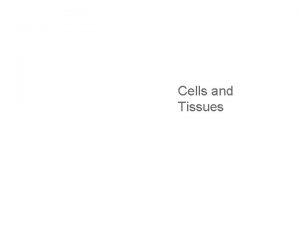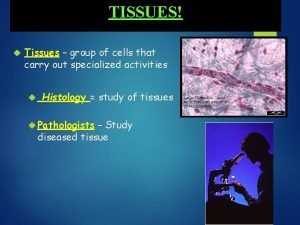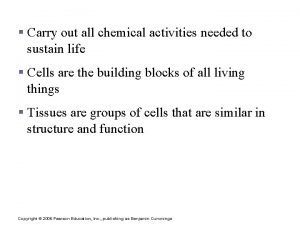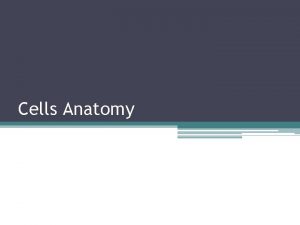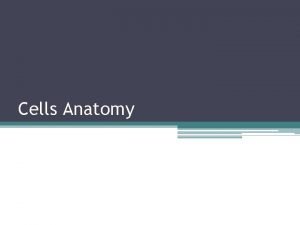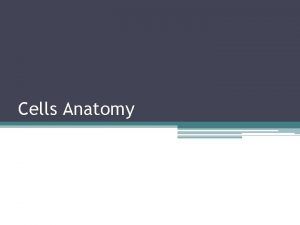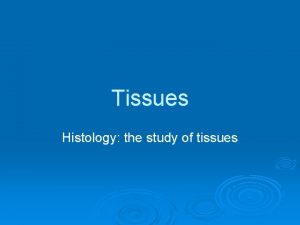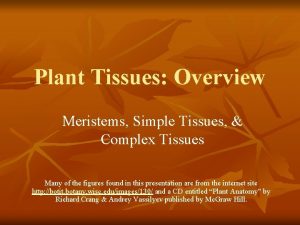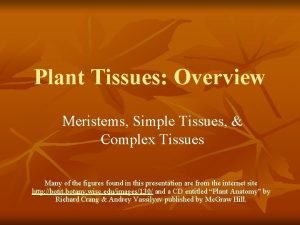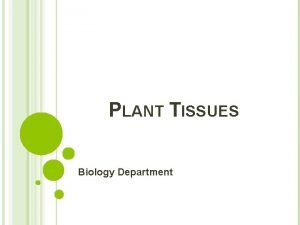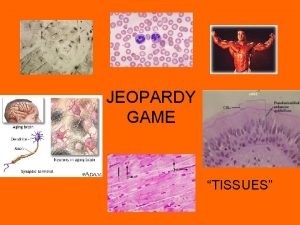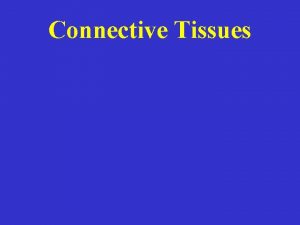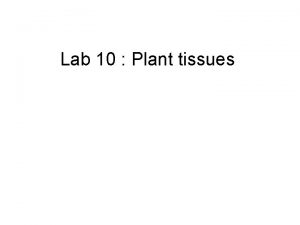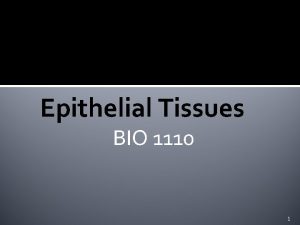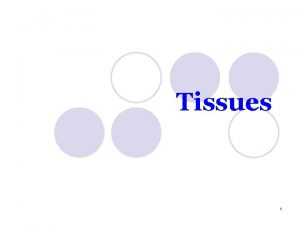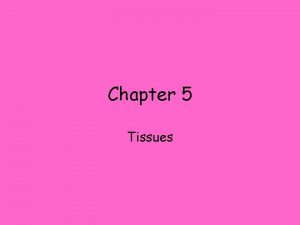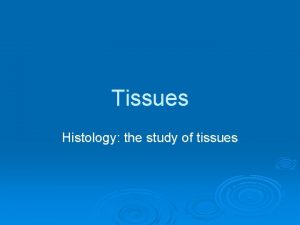Cells Tissues Cells Cells Carry out all chemical
















































- Slides: 48

Cells & Tissues

Cells

Cells • Carry out all chemical activities needed to sustain life • Cells are the building blocks of all living things

Anatomy of the Cell • Cells are not all the same • All cells share general structures • Cells are organized into three main regions – Nucleus – Cytoplasm – Plasma membrane Figure 3. 1 a

The Nucleus • Control center of the cell – Contains genetic material (DNA) • Three regions – Nuclear membrane – Nucleolus – Chromatin Figure 3. 1 b

Nuclear Membrane • Barrier of nucleus • Consists of a double phospholipid membrane • Contain nuclear pores that allow for exchange of material with the rest of the cell

Nucleoli • Nucleus contains one or more nucleoli • Sites of ribosome production – Ribosomes then migrate to the cytoplasm through nuclear pores

Chromatin • Composed of DNA and protein • Scattered throughout the nucleus • Chromatin condenses to form chromosomes when the cell divides

Plasma Membrane • Barrier for cell contents • Double phospholipid layer – Hydrophilic heads – Hydrophobic tails • Also contains protein, cholesterol, and glycoproteins

Plasma Membrane Figure 3. 2

Plasma Membrane Specializations • Microvilli – Finger-like projections that increase surface area for absorption Figure 3. 3

Plasma Membrane Specializations • Membrane junctions – Tight junctions – Desmosomes – Gap junctions Figure 3. 3

Cytoplasm • Material outside the nucleus and inside the plasma membrane – Cytosol • Fluid that suspends other elements – Organelles • Metabolic machinery of the cell – Inclusions • Non-functioning units

Cytoplasmic Organelles Figure 3. 4

Cytoplasmic Organelles • Ribosomes – Made of protein and RNA – Sites of protein synthesis – Found at two locations • Free in the cytoplasm • Attached to rough endoplasmic reticulum

Cytoplasmic Organelles • Endoplasmic reticulum (ER) – Fluid-filled tubules for carrying substances – Two types of ER • Rough Endoplasmic Reticulum – Studded with ribosomes – Site where building materials of cellular membrane are formed • Smooth Endoplasmic Reticulum – Functions in cholesterol synthesis and breakdown, fat metabolism, and detoxification of drugs

Cytoplasmic Organelles • Golgi apparatus – Modifies and packages proteins – Produces different types of packages • Secretory vesicles • Cell membrane components • Lysosomes

Golgi Apparatus Figure 3. 6

Cytoplasmic Organelles • Lysosomes – Contain enzymes that digest nonusable materials within the cell • Peroxisomes – Membranous sacs of oxidase enzymes • Detoxify harmful substances • Break down free radicals (highly reactive chemicals) – Replicate by pinching in half

Cytoplasmic Organelles • Mitochondria – “Powerhouses” of the cell – Change shape continuously – Carry out reactions where oxygen is used to break down food – Provides ATP for cellular energy

Cytoplasmic Organelles • Cytoskeleton – Network of protein structures that extend throughout the cytoplasm – Provides the cell with an internal framework Figure 3. 7 a

Cytoplasmic Organelles • Cytoskeleton – Three different types • Microfilaments • Intermediate filaments • Microtubules Figure 3. 7 b–d

Cytoplasmic Organelles • Centrioles – Rod-shaped bodies made of microtubules – Direct formation of mitotic spindle during cell division

Cellular Projections • Not found in all cells • Used for movement – Cilia moves materials across the cell surface – Flagellum propels the cell

Cell Diversity Figure 3. 8 a–b

Cell Diversity Figure 3. 8 c

Cell Diversity Figure 3. 8 d–e

Cell Diversity Figure 3. 8 f–g

Cellular Physiology: Membrane Transport • Membrane Transport – movement of substance into and out of the cell • Transport is by two basic methods – Passive transport • No energy is required – Active transport • The cell must provide metabolic energy

Solutions and Transport • Solution – homogeneous mixture of two or more components – Solvent – dissolving medium – Solutes – components in smaller quantities within a solution • Intracellular fluid – nucleoplasm and cytosol • Interstitial fluid – fluid on the exterior of the cell

Selective Permeability • The plasma membrane allows some materials to pass while excluding others • This permeability includes movement into and out of the cell

Passive Transport Processes • Diffusion – Particles tend to distribute themselves evenly within a solution – Movement is from high concentration to low concentration, or down a concentration gradient Figure 3. 9

Passive Transport Processes • Types of diffusion – Simple diffusion • Unassisted process • Solutes are lipid-soluble materials or small enough to pass through membrane pores

Passive Transport Processes • Types of diffusion – Osmosis – simple diffusion of water • Highly polar water easily crosses the plasma membrane – Facilitated diffusion • Substances require a protein carrier for passive transport

Diffusion through the Plasma Membrane Figure 3. 10

Passive Transport Processes • Filtration – Water and solutes are forced through a membrane by fluid, or hydrostatic pressure – A pressure gradient must exist • Solute-containing fluid is pushed from a high pressure area to a lower pressure area

Active Transport Processes • Transport substances that are unable to pass by diffusion – They may be too large – They may not be able to dissolve in the fat core of the membrane – They may have to move against a concentration gradient • Two common forms of active transport – Solute pumping – chemical exchanges – Bulk transport - exocytosis

Active Transport Processes -Solute pumping- Figure 3. 11

Exocytosis Figure 3. 12 a

Endocytosis Extracellular engulfs substances by enclosing in a membranous vescicle 2 types 1. Phagocytosis – cell eating 2. Pinocytosis – cell drinking Figure 3. 13 a

Cell Life Cycle • Cells have two major periods – Interphase • Cell grows • Cell carries on metabolic processes – Cell division • Cell replicates itself • Function is to produce more cells for growth and repair processes

DNA Replication • Genetic material duplicated and readies a cell for division into two cells • Occurs toward the end of interphase • DNA uncoils and each side serves as a template Figure 3. 14

Events of Cell Division • Mitosis – Division of the nucleus – Results in the formation of two daughter nuclei • Cytokinesis – Division of the cytoplasm – Begins when mitosis is near completion – Results in the formation of two daughter cells

Stages of Mitosis • Interphase – No cell division occurs – The cell carries out normal metabolic activity and growth • Prophase – First part of cell division – Centromeres migrate to the poles

Stages of Mitosis • Metaphase – Spindle from centromeres are attached to chromosomes that are aligned in the center of the cell

Stages of Mitosis • Anaphase – Daughter chromosomes are pulled toward the poles – The cell begins to elongate • Telophase – Daughter nuclei begin forming – A cleavage furrow (for cell division) begins to form

Stages of Mitosis Figure 3. 15

Stages of Mitosis Figure 3. 15(cont)
 Body tissue
Body tissue Four major tissue types
Four major tissue types Body tissues chapter 3 cells and tissues
Body tissues chapter 3 cells and tissues Eisonophil
Eisonophil Anatomy chapter 3 cells and tissues
Anatomy chapter 3 cells and tissues Get out get out get out of my head one direction
Get out get out get out of my head one direction Tissues are groups of similar cells working together to
Tissues are groups of similar cells working together to Tissues are groups of similar cells working together to
Tissues are groups of similar cells working together to Divisions of anatomy
Divisions of anatomy Chapter 3 cells and tissues figure 3-7
Chapter 3 cells and tissues figure 3-7 Cell membrane phospholipids
Cell membrane phospholipids Chapter 3 cells and tissues figure 3-1
Chapter 3 cells and tissues figure 3-1 Tissues are groups of similar cells working together to:
Tissues are groups of similar cells working together to: What do all connective tissues have in common
What do all connective tissues have in common Sistem all in all out
Sistem all in all out Carry out the research
Carry out the research My reason for joining extension work activities
My reason for joining extension work activities The crucible final test
The crucible final test What function does atp carry out in living things
What function does atp carry out in living things Food test for reducing sugar
Food test for reducing sugar Opposite rays
Opposite rays All waves carry what
All waves carry what Section 2 classifying chemical reactions worksheet answers
Section 2 classifying chemical reactions worksheet answers Empirical formula and molecular formula pogil
Empirical formula and molecular formula pogil Chemical reactions section 2 classifying chemical reactions
Chemical reactions section 2 classifying chemical reactions Section 1 chemical changes
Section 1 chemical changes Modern chemistry chapter 7 test answer key
Modern chemistry chapter 7 test answer key Are kc and kp equal
Are kc and kp equal Specialised connective tissues
Specialised connective tissues What are the 4 types of tissues
What are the 4 types of tissues Procambium
Procambium 3 tissues of a plant
3 tissues of a plant Plant tissue and organs
Plant tissue and organs Jane campion tissues
Jane campion tissues Leaf tissues
Leaf tissues Tissues causes of civil war
Tissues causes of civil war Tissues anatomy
Tissues anatomy Character of connective tissue
Character of connective tissue Genetic effects on gene expression across human tissues
Genetic effects on gene expression across human tissues Define connective tissue
Define connective tissue Chapter 6 bones and skeletal tissues
Chapter 6 bones and skeletal tissues Types of tissues
Types of tissues Cutaneous membrane
Cutaneous membrane Poem about tissues
Poem about tissues Types of tissues
Types of tissues What macromolecule is a prominent part of animal tissues
What macromolecule is a prominent part of animal tissues Supportive tissues
Supportive tissues What is this tissue
What is this tissue Identify
Identify







